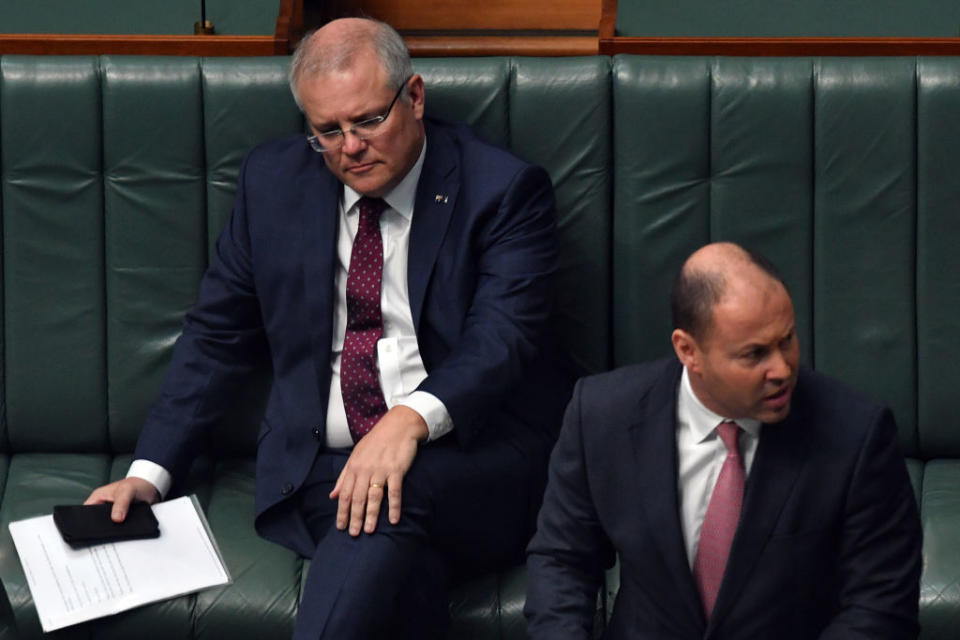'Catastrophic': Why government debt is a ticking time bomb

Long after the Covid-19 health crisis has passed, Australia will have to deal with an extraordinary level of government debt.
Government debt is skyrocketing with each stimulus payment and as the shortfall in tax revenue from the recession blows out the budget deficit to levels not seen since World War Two.
On current figuring, government debt will hit at least $800 billion if things go well – it will exceed $1 trillion in 2022-23 if the post-COVID-19 economy remains weak.
This is an important side effect of the policies taken to stamp out COVID-19 from Australia.
No one sensible is suggesting the government, in the current COVID-19 crisis, has overspent or overstimulated the economy. Even with the measures to date, including from the RBA, Australia is likely to see close to a double digit unemployment rate in concert with a double digit underemployment rate.
In other words, more than 20% of the workforce underutilised.
This is catastrophic.
Such is the economic fall out that more fiscal measures are likely to be rolled out to protect jobs and businesses in the near term and then gear up the economy for a strong recovery when the health crisis passes.
More from The Kouk: When should the Government ease restrictions?
More from The Kouk: Why this number is just as important as the jobless rate
More from The Kouk: 'Only the government can do this': The case against small government
Debt servicing costs are the issue
The issue with the explosion of government debt is not specifically the level of that debt, but rather the cost to the budget of servicing that debt – the annual interest payments in other words.
It is important to note that the government has to allocate monies from the annual budget to pay the interest on this debt. There is no discretion in this expenditure.
Government debt matters most because of the uncertainty around interest rates. When they are low, like now where globally interest rates are at a 2,000 year low, debt servicing costs are manageable. When interest rates are high, it can be a problem.
Interest rates are the random variable that determines the annual interest cost for any given level of debt.
In recent years, a series of fresh record lows for interest rates and government bond yields has kept debt servicing costs well contained, even as debt has increased.
Even allowing for that extremely favourable influence, the annual net interest cost on government debt before the crisis was $15.1 billion or 0.8% of GDP (2018-19).
Interest rates cannot fall much further
It seems unlikely that interest rates will fall much further in the years ahead and the risks are that government bond yields will be higher than today’s crisis levels in the mid-2020s.
Indeed, that seems a certainty.
If the level of government debt is rising in tandem with rising interest rates in three or four years time, the debt servicing costs will consume an even larger share of government outlays and scarce tax revenue will be needed to meet this costs.
The interest cost of debt issued to date to cover the COVID-19 crisis is remarkably low which is good news. The addition to the government’s debt interest costs will nonetheless be billions of dollars per annum. An extra $300 billion of government debt as a result of COVID-19 issues at an average interest rate of, say, 0.65% is an annual increase in debt servicing of around $2 billion per annum.
If in the next few years when the health aspect of the COVID-19 crisis is hopefully behind us, and interest rates are even marginally higher, debt servicing costs will escalate.
While higher interest rates are highly unlikely any time soon, part of prudent budget management from the government should have this interest rates risk in mind.
An interest rate regime even a few percentage points higher with debt levels elevated and rising would undermine the ability of the government to implement much needed economic and social reforms, many of which will be expensive.
What would higher interest rates mean?
Three years ago, the interest rate on government bond yields were approximately 2 percentage points higher than today.
If in the next few years government debt is $1 trillion and the average interest rate structure rises by 2 percentage points, the government’s annual interest bill could rise by around $20 billion to around $35 billion. (Note there are a series of bond maturities that may have been issued with higher yields many years ago which will be refinanced over time which complicates this exact calculation.)
Good government policy would have this at the forefront of its thinking and economic strategy. It is important to ensure Australia is not unduly exposed to an interest rate shock.
When the health crisis passes and the economy is strong, there will be a hot debate about government debt and how to get it back to levels that does not leave Australia vulnerable to an unexpected lift in interest rates and a blow out in the cost of servicing that debt.

 Yahoo Finance
Yahoo Finance 
